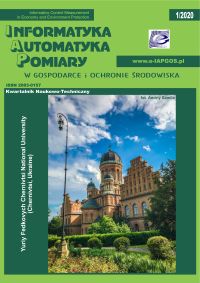APPLICATION OF HURST INDICATOR TO CHOOSE AN ALGORITHM FOR RESOURCE CONTROL OF A TELECOMMUNICATION NETWORK
Article Sidebar
Open full text
Issue Vol. 10 No. 1 (2020)
-
APPLICATION OF HURST INDICATOR TO CHOOSE AN ALGORITHM FOR RESOURCE CONTROL OF A TELECOMMUNICATION NETWORK
Anton Vrublevskiy, Ivan Lesovoy, Gennadij Pylypenko4-7
-
BLOCK CIPHERS ON THE BASIS OF REVERSIBLE CELLULAR AUTOMATA
Yuliya Tanasyuk, Petro Burdeinyi8-11
-
TIME INTERVAL SWITCHING DEVICE
Ruslan Politanskyi, Andrij Veryga12-15
-
ENVIRONMENT OF ELECTROMAGNETIC COMPATIBILITY OF RADIO-ELECTRONIC COMMUNICATION MEANS
Heorhii Rozorinov, Oleksandr Hres, Volodymyr Rusyn, Petro Shpatar16-19
-
THE GENERATING RANDOM SEQUENCES WITH THE INCREASED CRYPTOGRAPHIC STRENGTH
Volodymyr Korchynskyi, Vitalii Kildishev, Oleksandr Riabukha, Oleksandr Berdnikov20-23
-
THE INCREASE OF THE ENERGY EFFICIENCY OF THE RADIO EQUIPMENT BASED ON THE USE OF MODULATION BY ORTHOGONAL HARMONIC CARRIERS
Sergey Toliupa, Vladimir Nakonechnyi, Alexander Trush24-27
-
SYNTHESIS OF SAFE BEHAVIOR ALGORITHMS OF RADIOELECTRONIC SYSTEMS FOR CRITICAL APPLICATIONS
Leonid Ozirkovskyy, Bohdan Volochiy, Mykhailo Zmysnyi, Oleksandr Shkiliuk28-31
-
METHOD FOR ASSESSING THE STRUCTURAL RELIABILITY OF NETWORKS WITH UNDETERMINED TOPOLOGY
Nina Kniazieva, Alexey Nenov, Irina Kolumba32-35
-
PHOTODIODE BASED ON THE EPITAXIAL PHOSPHIDE GALLIUM WITH INCREASED SENSITIVITY AT A WAVELENGTH OF 254 nm
Yurii Dobrovolsky, Volodymyr M. Lipka, Volodymyr V. Strebezhev, Yurii O. Sorokatyi, Mykola O. Sorokatyi, Olga P. Andreeva36-39
-
DETERMINATION OF THE STRUCTURAL STATE AND STABILITY OF THE LASER CRYSTALLIZED Cd1-xМnxTe CRYSTAL SURFACE
Victor Strebezhev, Ivan Yuriychuk, Petro Fochuk, Sergiy Nichyi, Yuriy Dobrovolsky, Victoria Tkachuk, Mykola Sorokatyi, Yurii Sorokatyi40-43
-
TECHNOLOGY AND MEASUREMENTS OF MAGNETORESISTANCE IN THIN-LAYERED FERROMAGNETIC STRUCTURES
Jakub Kisała, Karolina Czarnacka, Mateusz Gęca, Andrzej Kociubiński44-47
-
STUDYING THE PROPERTIES OF PIXELS PERMUTATIONS BASED ON DISCRETIZED STANDARD MAP
Serhii Haliuk, Oleh Krulikovskyi, Vitalii Vlasenko48-51
-
FACE RECOGNITION TECHNIQUES
Olexandr N. Romanyuk, Sergey I. Vyatkin, Sergii V. Pavlov, Pavlo I. Mykhaylov, Roman Y. Chekhmestruk, Ivan V. Perun52-57
-
INVESTIGATION OF THE KOLMOGOROV-WIENER FILTER FOR CONTINUOUS FRACTAL PROCESSES ON THE BASIS OF THE CHEBYSHEV POLYNOMIALS OF THE FIRST KIND
Vyacheslav Gorev, Alexander Gusev, Valerii Korniienko58-61
-
MODELLING OF SPINTRONIC DEVICES FOR APPLICATION IN RANDOM ACCESS MEMORY
Ruslan Politanskyi, Maria Vistak, Andriy Veryga, Tetyana Ruda62-65
-
HARDWARE AND SOFTWARE MEANS FOR ELECTRONIC COMPONENTS AND SENSORS RESEARCH
Gryhoriy Barylo, Oksana Boyko, Ihor Gelzynskyy, Roman Holyaka, Zenon Hotra, Tetyana Marusenkova, Mykola Khilchuk, Magdalena Michalska66-71
-
WAYS TO PRODUCE RENEWABLE ENERGY FROM CARBON DIOXIDE
Natalia Grigorieva, Viktor Shabaykovich, Larysa Gumeniuk, Pavlo Humeniuk, Lubov Dobrovolska, Dmitry Sobchuk72-76
-
SATURATION OF THE ABSORPTION OF THERMAL RADIATION BY ATMOSPHERIC CARBON DIOXIDE
Jan Kubicki, Krzysztof Kopczyński, Jarosław Młyńczak77-81
-
CLASSIFICATION OF MULTIDIMENSIONAL POLARIZATION MICROSCOPY RESULTS IN THE TECHNOLOGY OF FORENSIC INTELLECTUAL MONITORING OF HEART DISEASES
Oleg Vanchulyak, Serhii Golub, Mariia Talakh, Vyacheslav Gantyuk82-86
Archives
-
Vol. 12 No. 4
2022-12-30 16
-
Vol. 12 No. 3
2022-09-30 15
-
Vol. 12 No. 2
2022-06-30 16
-
Vol. 12 No. 1
2022-03-31 9
-
Vol. 11 No. 4
2021-12-20 15
-
Vol. 11 No. 3
2021-09-30 10
-
Vol. 11 No. 2
2021-06-30 11
-
Vol. 11 No. 1
2021-03-31 14
-
Vol. 10 No. 4
2020-12-20 16
-
Vol. 10 No. 3
2020-09-30 22
-
Vol. 10 No. 2
2020-06-30 16
-
Vol. 10 No. 1
2020-03-30 19
-
Vol. 9 No. 4
2019-12-16 20
-
Vol. 9 No. 3
2019-09-26 20
-
Vol. 9 No. 2
2019-06-21 16
-
Vol. 9 No. 1
2019-03-03 13
-
Vol. 8 No. 4
2018-12-16 16
-
Vol. 8 No. 3
2018-09-25 16
-
Vol. 8 No. 2
2018-05-30 18
-
Vol. 8 No. 1
2018-02-28 18
Main Article Content
DOI
Authors
Abstract
It has been shown that fuzzy integrals (Sugeno and Shocke) have special properties and are suitable for a fuzzy system for managing the resources of a telecommunication network. The form of choosing a method for calculating the Hurst coefficient in a fuzzy control system for telecommunication network resources is proposed.
Keywords:
References
Bychkov Ye. D.: Prilozheniye teorii nechetkikh (FUZZY) mnozhestv v matematicheskikh modelyakh sistem svyazi. Izd-vo Omskoy Gos. Med. Akademii, Omsk 2000.
Dang T. D., Sonkoly В., Molnar S.: Fractal Analysis and Modelling of VoIP Traffic. NETWORKS-2004. Vienna. Austria. 2004, 95–104.
Dubois D., Prad H.: Fuzzy Sets and Systems: Theory and applications. Acad. Press, New York 1980.
Ghaderi M.: On the Relevance of Self-Similarity in Network Traffic Prediction. School of Computer Science, University of Waterloo, Waterloo 2003.
Ilnickis S.: Research of the Network Server in Self-Similar Traffic Environment. Scientific proceedings of Riga Tecnical University Telecommunication and Electronics. Computer Science l/2004, 78–81.
Karasaridis A., Hatzinakos D.: Network Heavy Traffic Modeling Using a-stable Self-Smilar Process. IEEE Transactin on Communications 49(7)/2001, 1203–1214. DOI: https://doi.org/10.1109/26.935161
Neyman V. I.: Novoye napravleniye v teorii teletrafika. Elektrosvyaz' 7/1998, 27–29.
Osin A. V.: Vliyaniye samopodobnosti rechevogo trafika na kachestvo obsluzhivaniya v telekommunikatsionnykh setyakh. PhD thesis, Moscow 2005.
Pospelov D. A.: Nechetkiye mnozhestva v modelyakh upravleniya i iskusstvennogo intellekta. Nauka, Moscow 1986.
Shelukhin O. I. (red.): Fraktal'nyye protsessy v telekommunikatsiyakh. Radiotekhnika, Moscow 2003.
Sugeno M.: Fuzzy measures and fuzzy integrals: a survey. Fuzzy automata and decision processes. North-Holland Publishning Company, Amsterdam 1977, 89–102.
Tsybakov B. S., Georganas N. D.: Self-Similar Processes in Communications Networks. IEEE Trans. on Information Theory 44(5)/1998, 1713–1725. DOI: https://doi.org/10.1109/18.705538
Article Details
Abstract views: 345
License

This work is licensed under a Creative Commons Attribution-ShareAlike 4.0 International License.






